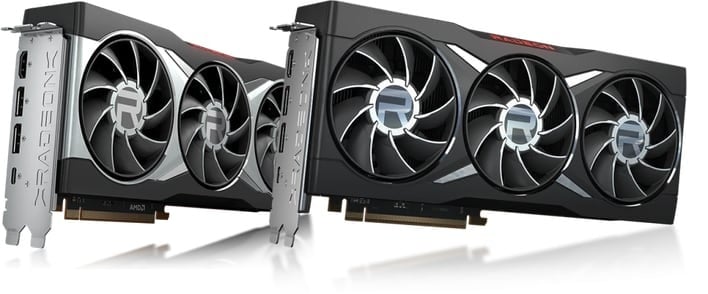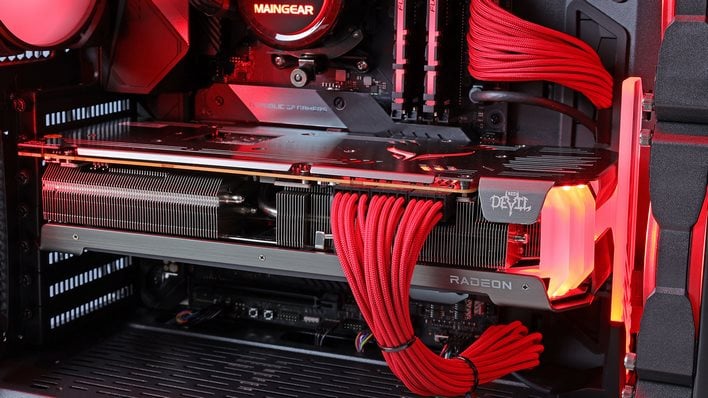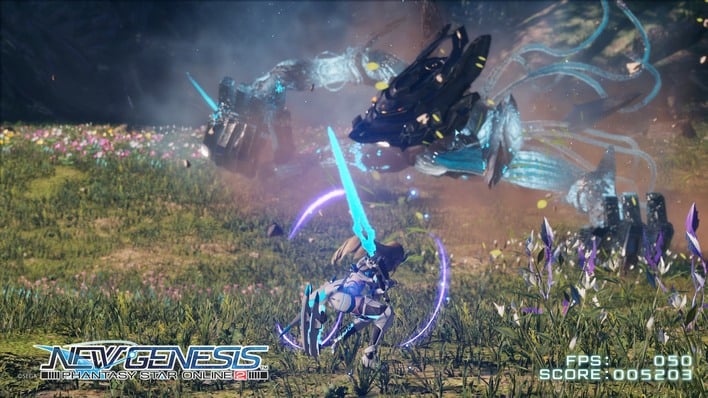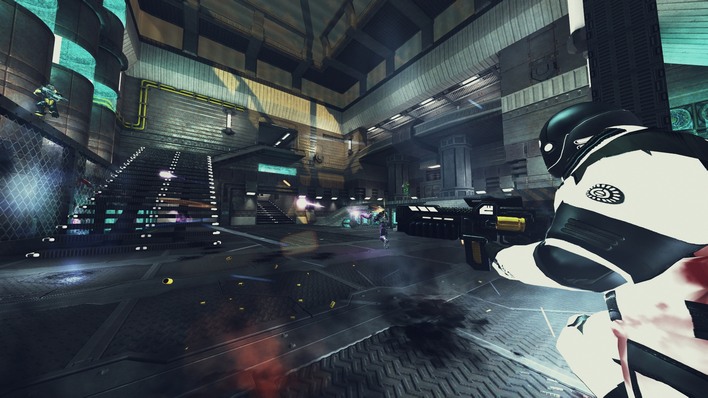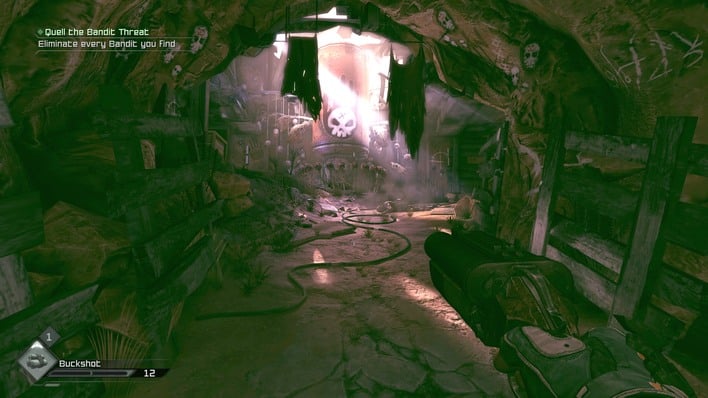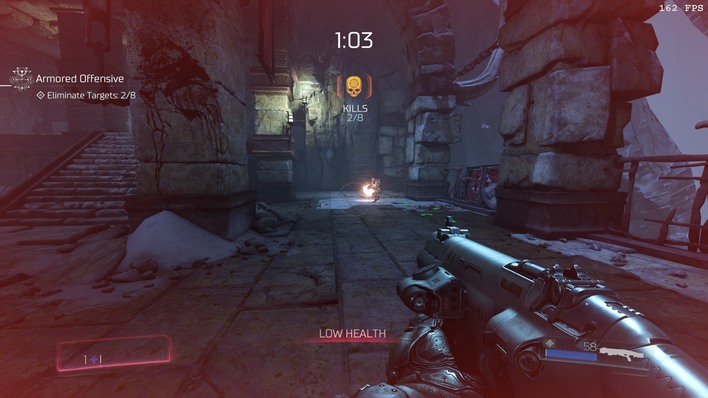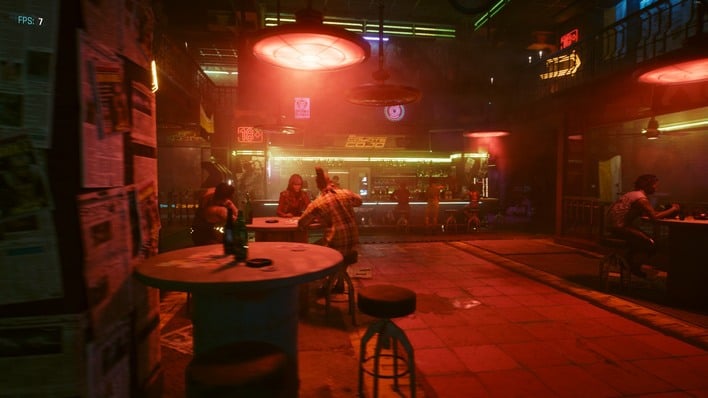AMD Adrenalin 22.7.1 Driver Performance Test: Big Gains in DX11 & OpenGL
Of course big tech companies make proclamations of "new and improved" every day, but it is not always just marketing hype. Back in May, AMD debuted what it claimed was a "rebuilt from the ground up" DirectX 11 driver, and now, with this latest release, the company has revised its OpenGL driver, too. Let's look at some of their claims...
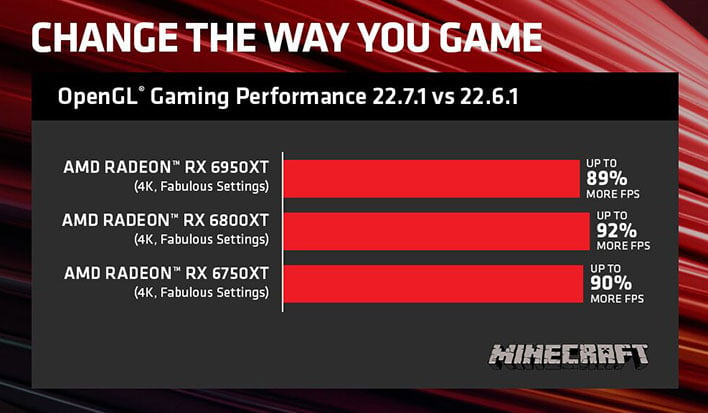
All of the tests were done on a test bench with a Ryzen 7 5800X3D CPU, 32GB of low-latency DDR4-3600 memory, and AMD's own Radeon RX 6800 XT card. All driver settings were left at their defaults and we did not adjust any Windows settings, either. That means the Balanced power profile, Game Mode was left on, and AMD SmartAccess Memory was enabled.
So, without further ado, let's dive into the benchmarks, shall we?
3DMark Fire Strike Benchmark


The gains are small, to be sure—but they're real and consistent. Like with all of the rest of our benchmarks, we ran each test three times, and then took the middle of the three results. This prevents our results from being outliers, and ensures that they should be at least reasonably representative.
The 3DMark results hint at an interesting pattern. The new driver does improve GPU performance ever so slightly in this benchmark, but it also raises the normally-very-consistent Physics score. This score is basically Fire Strike's "CPU" score, and the new driver improving that seems to mean that the Radeon card is better able to make use of our Ryzen 7 5800X3D's horsepower.
Final Fantasy XIV Endwalker Benchmark
One of our favorite things about Final Fantasy XIV is that Square-Enix continues to release new character creator and benchmark tools with each expansion. The updated benchmarks are intended to better represent the demands of the content in the latest expansion.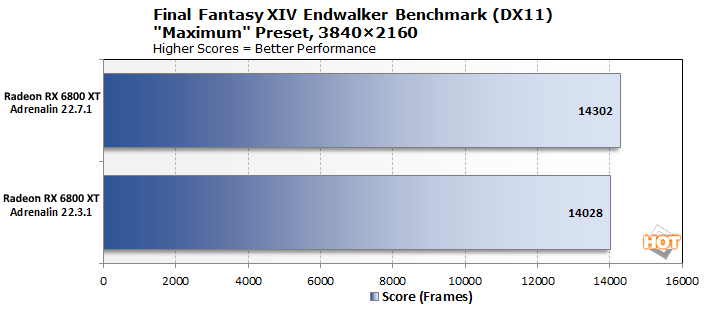
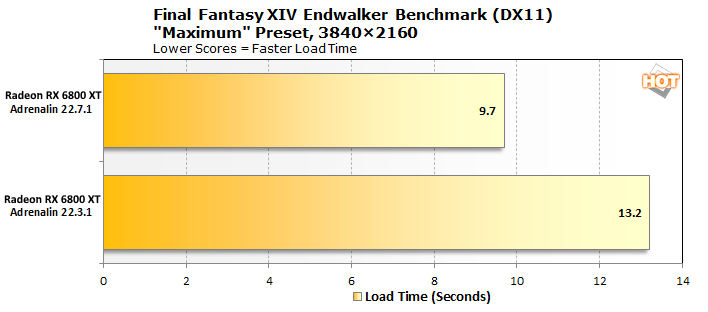
Phantasy Star Online 2: New Genesis Benchmark
No matter how you slice it, PSO2:NGS runs a lot worse than it should on any system. SEGA has some optimization work to do for sure, although we must note that the game runs a lot better in its current patch than it did on release. Unfortunately, the benchmark tool is based on that original release. Hopefully SEGA can follow in Square-Enix's footsteps and release a new benchmark with the current version of the engine.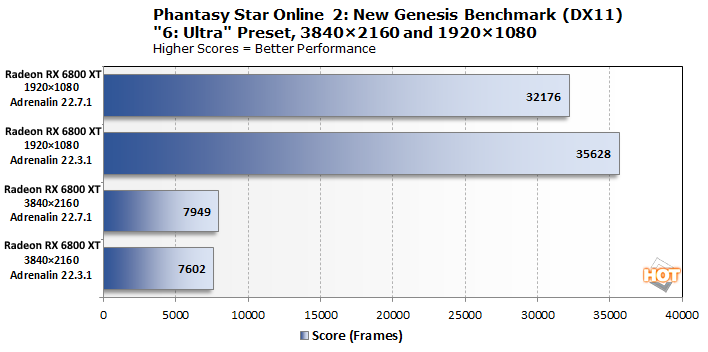
Don't read too much into the 1920×1080 results. The game has a hard framerate cap at 180 FPS, and scores over 30,000 mean that you're staying right near that cap for most of the benchmark. This test isn't completely deterministic either due to some randomness in the particle effects, and while it seems like a huge difference, these scores really aren't meaningful.
The more interesting gain is the ~5% uplift in 4K performance. Neither of these scores are particularly bad, but the new driver seems to have resolved some stuttering in the benchmark, and that appears to be what is improving performance here.
Counter-Strike: Global Offensive Benchmark

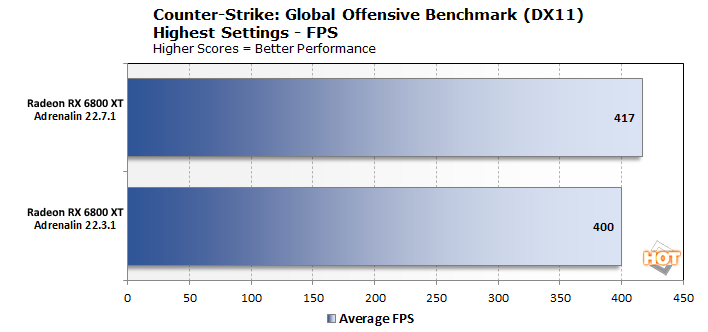
That is a 4.25% improvement, which is about what we've been seeing in DirectX 11 games. It may not be much, but an improvement is still an improvement, so we are pleased to see it.
ARMA III Benchmark
ARMA III is another game that is difficult to test owing to its primarily-multiplayer nature. Fortunately, like with CS:GO, fans have come together to create specialized scenarios that play through an automated benchmark, much like those available in other games. We used the popular "Yet Another ARMA Benchmark" scenario with all in-game settings turned to their maximums.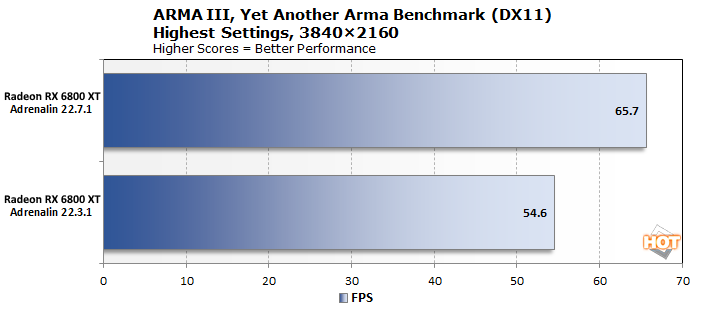
This is our biggest DirectX 11 gain yet, and the biggest one overall. ARMA III is a unique game in that it is extremely reliant on both single-threaded CPU performance and main memory bandwidth. While the engine it uses is multi-threaded to a degree, it really wants a super-fast CPU and system memory bus.
Of course, none of that changed between our tests; the only variable that moved is the graphics driver. All the in-game settings are the same; we checked! This result really points to some CPU usage optimizations in AMD's new DirectX 11 driver, just as we suspected with 3DMark and Final Fantasy XIV. 65.7 FPS in this benchmark is quite a high result; ARMA players, update your drivers immediately.
Wreckfest Benchmark
Wreckfest is a destruction derby-style racing title where players can select from a variety of destructible vehicles and either race them or attempt to smash their opponents out of the running. It's a surprisingly demanding game considering that it originally released in 2014. Bugbear Interactive's home-grown ROMU engine looks great and already ran pretty well on Radeon.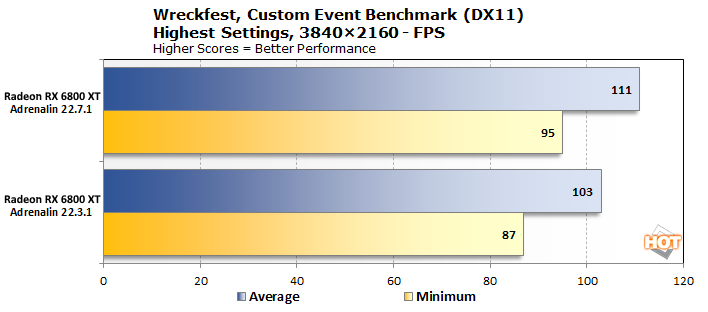
Even still, it runs better now. We set up a custom event using the Bloomfield Speedway and made sure to match weather conditions. There was still a surprising amount of non-determinism in this benchmark and so these results were a little inconsistent, but our strategy of running three times and picking the middle gave us a pretty solid improvement of just under 8% with Adrenalin 22.7.1.
Unigine Superposition Benchmark
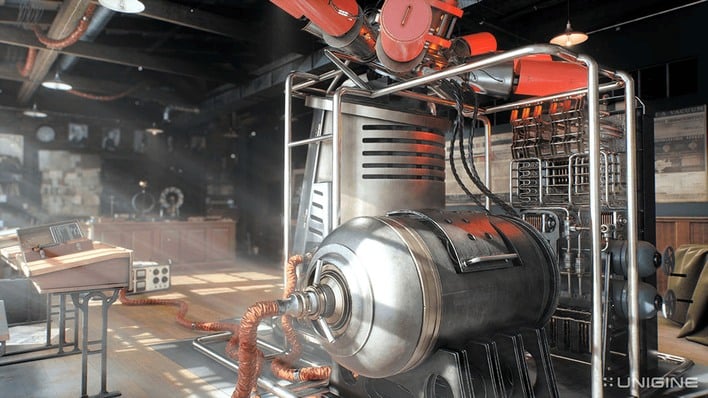
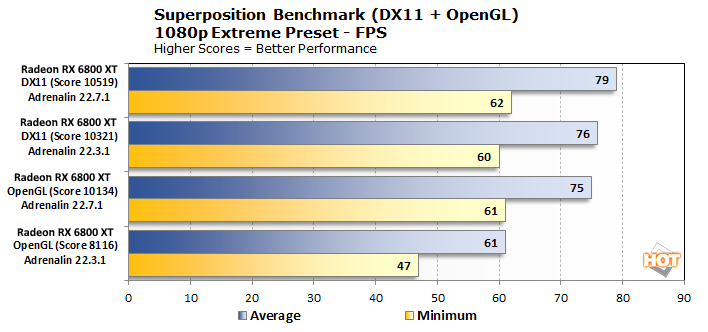
Superposition serves as a bit of a bridge for us between our DX11 tests and OpenGL titles. The benchmark supports both APIs, and naturally, the conventional wisdom on Radeon cards has been to run it in DirectX 11 mode owing to that mode's better performance on those cards.
Well, as you can see for yourself, that's not necessarily the case anymore. Okay, the DirectX 11 mode still performs a little better. The difference is vanishingly small, though, and it is not far from being run-to-run variance. The OpenGL mode of the benchmark performs excellently on our RX 6800 XT now, and the DirectX 11 mode even sees a very small uplift with the new driver. Excellent work, AMD.
Xonotic Benchmark
If you are looking at the title of that game—pronounced "zone-otic"—and wondering what the heck it is, don't worry. Xonotic is a free (as in speech) game based on a heavily modified version of the Quake engine. It was forked from an earlier title known as Nexuiz when that game decided to go commerical. Xonotic plays a lot like older arena FPS games such as Quake and Unreal, and it is a ton of fun with friends.
Testing Xonotic is a lot like testing the old Quake games was back in the day: you run a timedemo. This means that you play back a demo recording at the maximum speed possible for the machine and then compare that performance against the original speed. At the end of the demo, Xonotic spits out the minimum, average, and maximum one-second frame rates.
We tested Xonotic using the built-in "big key benchmark" demo, and the performance gains are plain to see. It would be easy to argue that 271 average FPS is plenty fast, even for a game like this, but you could really feel that 39 FPS low when playing, as performance would hitch and stutter at times. The new driver feels drastically smoother and makes this classic-style FPS a joy to play.
RAGE Benchmark
RAGE is one of your author's all-time favorite FPS games. Yes, his taste is widely-acknowledged to be terrible. It is a woefully-overlooked game, though, and despite releasing way back in 2011 it still has absolutely stellar visuals. It also runs like a dream... at least on GeForce hardware.Before the new driver, RAGE was a stuttery, awful mess on Radeon cards. Testing using Adrenalin 22.3.1, the game hitched and stuttered non-stop. Despite the framerate counter reading values as high as 95 FPS, it felt more like 45. Let's see what happens when AMD throws some optimizations at it.

Well, would you look at that. RAGE actually has a 60 FPS cap in place normally, and testing in 3840×2160, despite the stuttering, was still giving us average FPS values around 58. That simply wouldn't do, so we cranked the resolution all the way up to 7680×4320 and used a mod to uncap the framerate.
That gave us more useful values for testing, and the play experience bears out these results. With the new driver, RAGE is smooth as silk, and an absolute blast to play at 8K120. It loads in noticeably faster, too.
DOOM (2016) Benchmark
Our last two OpenGL results are, somewhat amusingly, both Doom games. Doom (2016) was the triumphant return for the series after the controversial Doom 3 in 2004. This game came out back in the days of the Radeon RX 480 and GeForce GTX 980. A lot of folks were still using older GPUs than that, like Radeon R9 290X jet engines and even GeForce GTX 580 BBQ grills. It did not have Vulkan support at launch, and playing Doom 4 on Radeon cards was rough until the new API was added. Is that still so?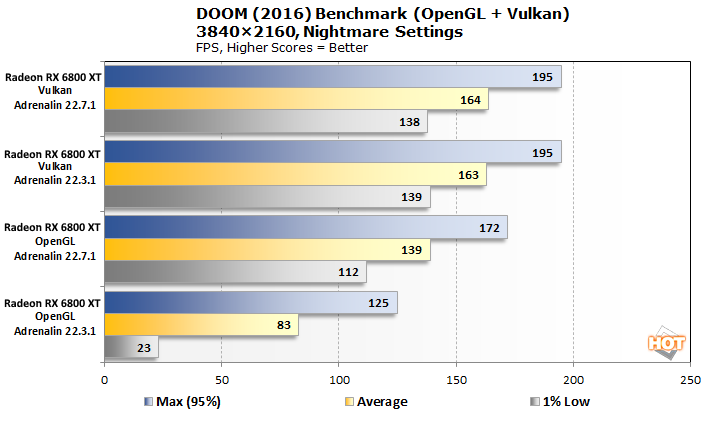
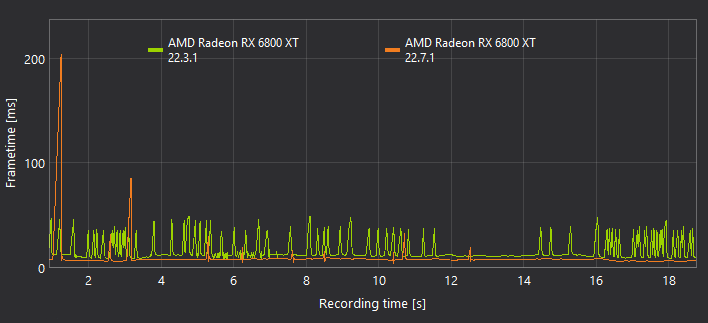
The green line represents the frametime with the 22.3.1 driver, and the orange line represents the frametime with the 22.7.1 driver. That huge spike at the beginning with the 22.7.1 driver is an artifact of the tool that we use to capture frametimes, CapFrameX; you can ignore that. Overall, the new driver is both faster and drastically smoother than the old driver.
ZDoom Eviternity Benchmark
On the face of it, it may seem silly to benchmark a mod for a 29-year-old game. Believe it or not, mods for that game can still put a heavy hurt on modern systems. We're testing ZDoom, a source port of Doom (1993), along with the level set Eviternity. The 26th map in this level set, the first map of its sixth episode, is known as Transcendence, and it is somewhat notorious for its terrible performance. Most of this comes down to gross inefficiencies in the Doom engine itself, which was never meant to handle levels of this size or complexity.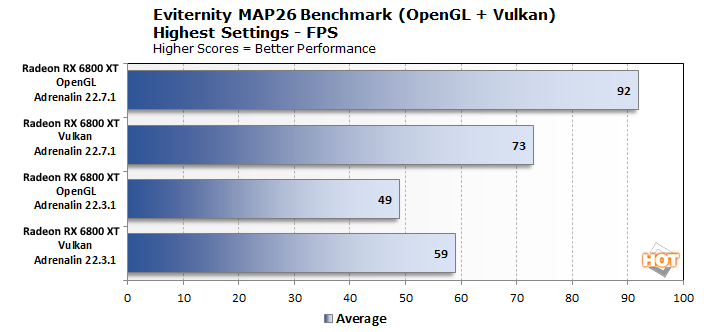
As with Doom '16, we tested ZDoom in both OpenGL and Vulkan. Surprisingly, despite AMD saying nothing about Vulkan gains in this driver update, the new driver runs considerably better in both OpenGL and Vulkan in this particular benchmark. We're ready to chalk that up to peculiarities of ZDoom, as its Vulkan renderer is probably closely related to its OpenGL renderer.
Cyberpunk 2077 Benchmark
Bringing up the rear is our sole DirectX 12 test. AMD has not mentioned anything in a while about its DX12 driver, but with all this work going on alongside, we wanted to make sure there had not been any regressions in Radeons' DirectX 12 or DXR ray-tracing performance. Cyberpunk 2077 makes the perfect test.
Using the built-in benchmark, we actually see a small performance improvement in Cyberpunk 2077 between the old and new drivers. This benchmark is not deterministic, but it is reasonably reliable from run-to-run and this result was fairly consistent. Clearly AMD's been trying to shore up its slightly sub-par ray-tracing performance. With these settings, Cyberpunk 2077 is quite playable and still looks pretty nice.
OpenGL Emulator Testing
One of the main uses of the OpenGL API for gamers on Windows is to play video games in console hardware emulators. Most emulator applications are open-source software, and that means that the developers often prefer to use cross-platform APIs. As a result, you do see a preference for OpenGL among emulator authors.Recently, that preference seems to have shifted toward Vulkan. The newer and lower-level API has all of the cross-platform advantages of OpenGL, yet none of the legacy cruft of that aged API. Vulkan works well on GPUs from every vendor, albeit with some inconsistencies in feature and extension support.
Still, there are a lot of emulators out there that perform or function best with OpenGL. One of the most notable is CEMU, the Wii U emulator. CEMU famously got Vulkan support at the very end of 2019, but certain mods and "graphics packs" for the emulator still require OpenGL. That essentially meant that Radeon players did not have access to those because OpenGL performance on those cards was so poor.
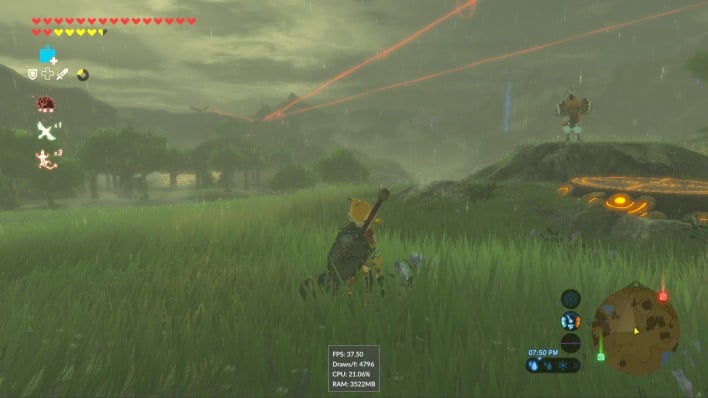
We also tested other emulators, including PCSX2 for the PlayStation 2, Yuzu emulator for the Nintendo Switch, and Mupen64Plus on Retroarch. All of them worked flawlessly with the new driver. This is great news for emulation fans using Radeon cards as well as integrated Radeon graphics.
Final Conclusions
Regular readers will recognize that our test set this time around was pretty strange. We did not run our usual batch of games because we generally focus on testing newer and more up-to-date titles, and those games do not typically employ DirectX 11 or OpenGL as their API.